engine VOLVO XC70 2003 Workshop Manual
[x] Cancel search | Manufacturer: VOLVO, Model Year: 2003, Model line: XC70, Model: VOLVO XC70 2003Pages: 257, PDF Size: 5.33 MB
Page 155 of 257

2003 VOLVO XC70
Three-way catalytic converter cautions
l Keep your engine properly tuned. Certain engine malfunctions, particular\
ly involving the electrical,
fuel or distributor ignition systems, may cause unusually high three-way\
catalytic converter
temperatures. Do not continue to operate your vehicle if you detect engine misfire, no\
ticeable loss of
power or other unusual operating conditions, such as engine overheating \
or backfiring. A properly
tuned engine will help avoid malfunctions that could damage the three-wa\
y catalytic converters.
l Do not park your car over combustible materials, such as grass or leaves\
, which can come into contact
with the hot exhaust system and cause such materials to ignite under cer\
tain wind and weather
conditions.
l Excessive starter cranking (in excess of one minute), with an intermit\
tently firing or flooded engine,
can cause three-way catalytic converter or exhaust system overheating.
l Remember that tampering or unauthorized modifications to the engine or t\
he vehicle may be illegal
and can cause three-way catalytic converter or exhaust system overheatin\
g. This includes:
- Altering fuel injection setting or components.
- Altering emission system components or location or removing components\
.
- Repeated use of leaded fuel.
NOTE: Unleaded fuel is required for cars with three-way catalytic converters \
Contents | Top of Page
file:///K|/ownersdocs/2003/2003_XC70/03xc70_06b.htm (10 of 10)12/30/20\
06 4:18:00 PM
Page 166 of 257
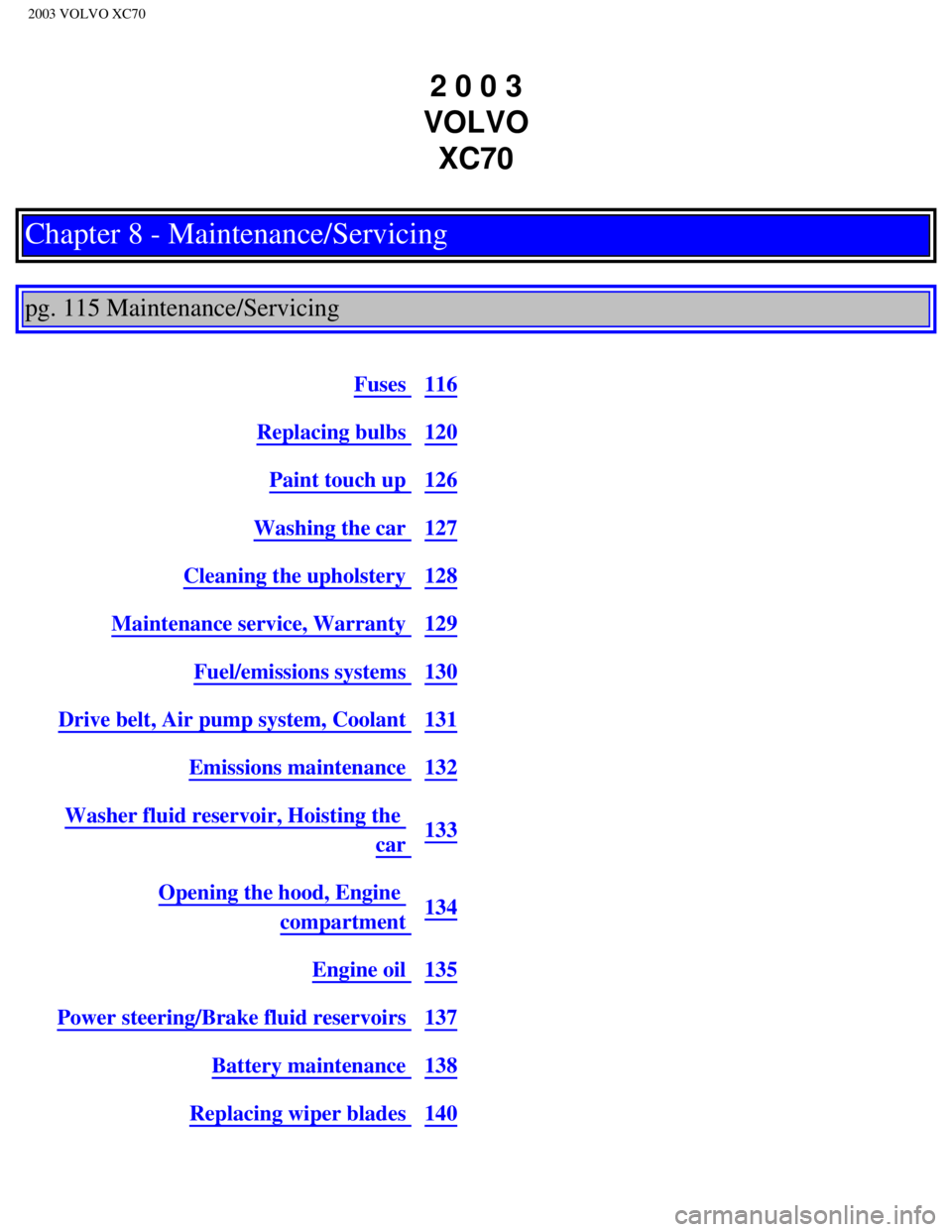
2003 VOLVO XC70
2 0 0 3
VOLVO XC70
Chapter 8 - Maintenance/Servicing
pg. 115 Maintenance/Servicing
Fuses 116
Replacing bulbs 120
Paint touch up 126
Washing the car 127
Cleaning the upholstery 128
Maintenance service, Warranty 129
Fuel/emissions systems 130
Drive belt, Air pump system, Coolant 131
Emissions maintenance 132
Washer fluid reservoir, Hoisting the
car 133
Opening the hood, Engine
compartment 134
Engine oil 135
Power steering/Brake fluid reservoirs 137
Battery maintenance 138
Replacing wiper blades 140
file:///K|/ownersdocs/2003/2003_XC70/03xc70_08a.htm (1 of 21)12/30/200\
6 4:18:03 PM
Page 167 of 257
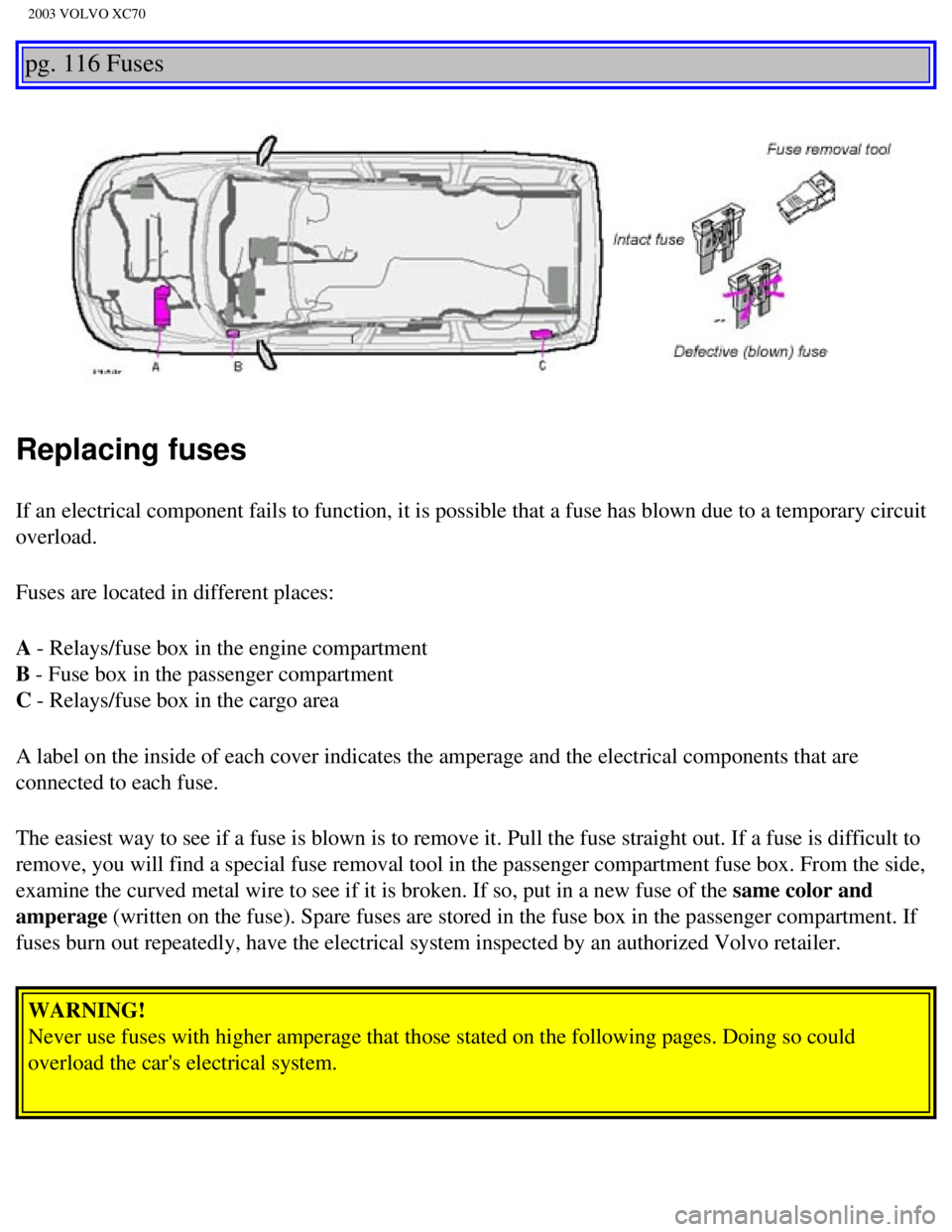
2003 VOLVO XC70
pg. 116 Fuses
Replacing fuses
If an electrical component fails to function, it is possible that a fuse\
has blown due to a temporary circuit
overload.
Fuses are located in different places:
A - Relays/fuse box in the engine compartment
B - Fuse box in the passenger compartment
C - Relays/fuse box in the cargo area
A label on the inside of each cover indicates the amperage and the elect\
rical components that are
connected to each fuse.
The easiest way to see if a fuse is blown is to remove it. Pull the fuse\
straight out. If a fuse is difficult to
remove, you will find a special fuse removal tool in the passenger compa\
rtment fuse box. From the side,
examine the curved metal wire to see if it is broken. If so, put in a ne\
w fuse of the same color and
amperage (written on the fuse). Spare fuses are stored in the fuse box in the \
passenger compartment. If
fuses burn out repeatedly, have the electrical system inspected by an au\
thorized Volvo retailer.
WARNING!
Never use fuses with higher amperage that those stated on the following \
pages. Doing so could
overload the car's electrical system.
file:///K|/ownersdocs/2003/2003_XC70/03xc70_08a.htm (2 of 21)12/30/200\
6 4:18:03 PM
Page 168 of 257

2003 VOLVO XC70
pg. 117 Fuses in the engine compartment
Relays/fuses in the engine compartment
When replacing fuses, be sure to replace a blown fuse with a new one of \
the same color and amperage
(written on the fuse). Fuse amperage is also indicated on the inside o\
f the fuse box cover.
A - To open, press the plastic catches on the rear side of the fuse box \
cover and lift
Ordinary fuses
Location Amperage
1 Accessories 25A
2 Auxiliary lamps (option) 20A
3 Vacuum pump 15A
4 Oxygen sensors 20A
5 Crankcase ventilation heater, solenoid valves 10A
6 Mass airflow sensor, engine control module, injectors 15A
7 Throttle module 10A
file:///K|/ownersdocs/2003/2003_XC70/03xc70_08a.htm (3 of 21)12/30/200\
6 4:18:03 PM
Page 169 of 257
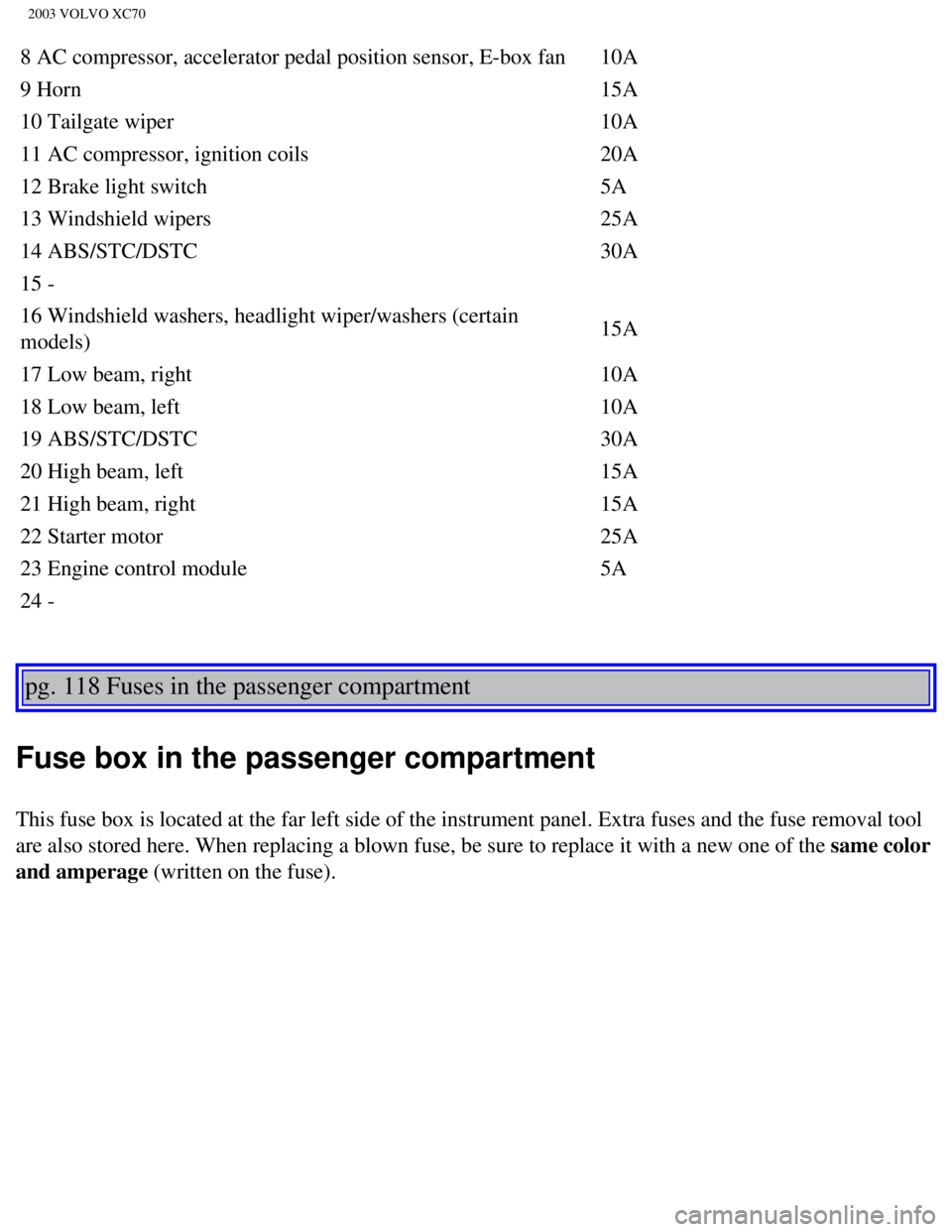
2003 VOLVO XC70
8 AC compressor, accelerator pedal position sensor, E-box fan 10A
9 Horn 15A
10 Tailgate wiper 10A
11 AC compressor, ignition coils 20A
12 Brake light switch 5A
13 Windshield wipers 25A
14 ABS/STC/DSTC 30A
15 -
16 Windshield washers, headlight wiper/washers (certain
models) 15A
17 Low beam, right 10A
18 Low beam, left 10A
19 ABS/STC/DSTC 30A
20 High beam, left 15A
21 High beam, right 15A
22 Starter motor 25A
23 Engine control module 5A
24 -
pg. 118 Fuses in the passenger compartment
Fuse box in the passenger compartment
This fuse box is located at the far left side of the instrument panel. E\
xtra fuses and the fuse removal tool
are also stored here. When replacing a blown fuse, be sure to replace it\
with a new one of the same color
and amperage (written on the fuse).
file:///K|/ownersdocs/2003/2003_XC70/03xc70_08a.htm (4 of 21)12/30/200\
6 4:18:03 PM
Page 171 of 257
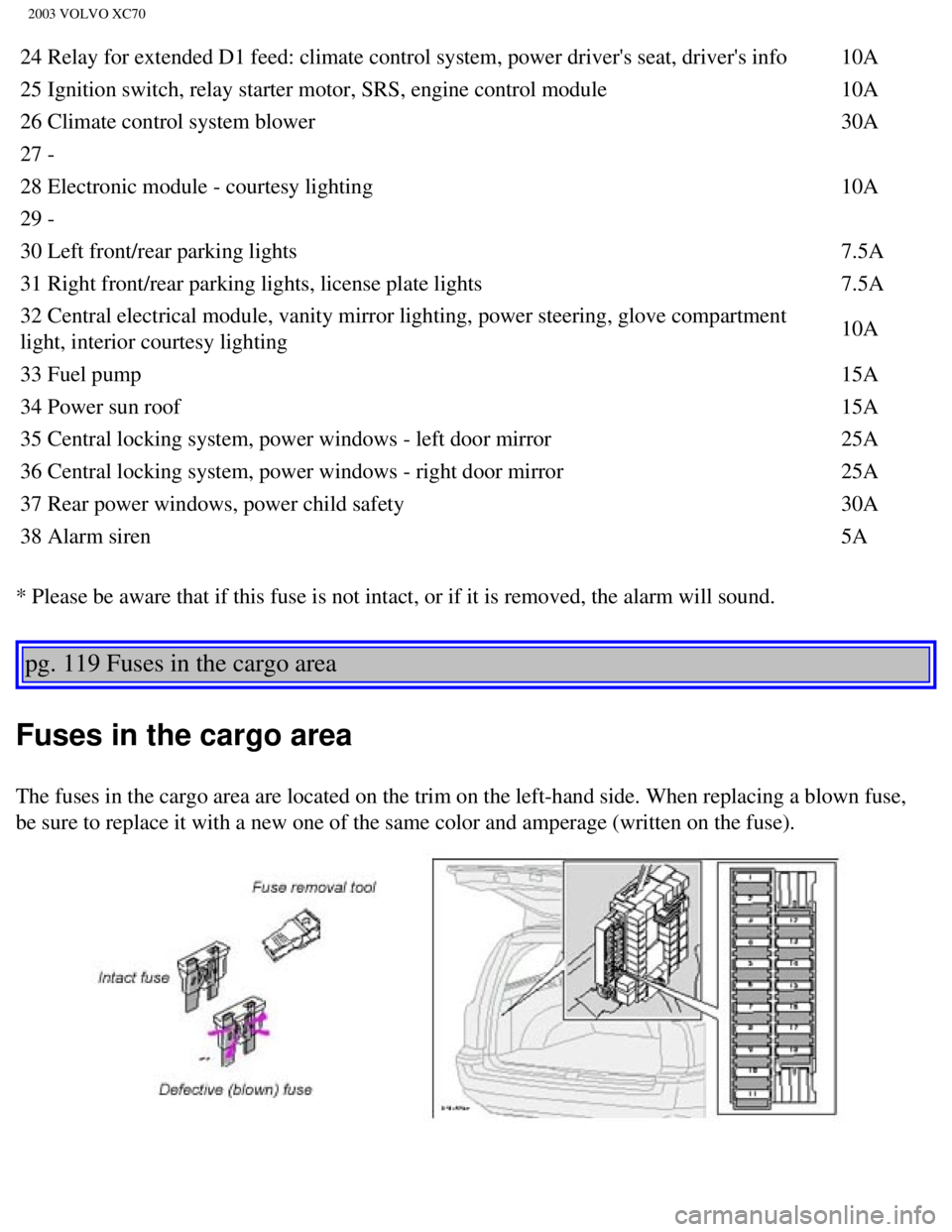
2003 VOLVO XC70
24 Relay for extended D1 feed: climate control system, power driver's se\
at, driver's info 10A
25 Ignition switch, relay starter motor, SRS, engine control module 10A
26 Climate control system blower 30A
27 -
28 Electronic module - courtesy lighting 10A
29 -
30 Left front/rear parking lights 7.5A
31 Right front/rear parking lights, license plate lights 7.5A
32 Central electrical module, vanity mirror lighting, power steering, gl\
ove compartment
light, interior courtesy lighting 10A
33 Fuel pump 15A
34 Power sun roof 15A
35 Central locking system, power windows - left door mirror 25A
36 Central locking system, power windows - right door mirror 25A
37 Rear power windows, power child safety 30A
38 Alarm siren 5A
* Please be aware that if this fuse is not intact, or if it is removed, \
the alarm will sound.
pg. 119 Fuses in the cargo area
Fuses in the cargo area
The fuses in the cargo area are located on the trim on the left-hand sid\
e. When replacing a blown fuse,
be sure to replace it with a new one of the same color and amperage (wr\
itten on the fuse).
file:///K|/ownersdocs/2003/2003_XC70/03xc70_08a.htm (6 of 21)12/30/200\
6 4:18:03 PM
Page 173 of 257

2003 VOLVO XC70
Replacing high/low beam headlight bulbs
The headlight bulbs must be replaced from the engine compartment.
CAUTION:
l Do not touch the glass on halogen bulbs with your fingers. Grease, oil o\
r any other impurities can be
carbonized onto the bulb and cause damage to the reflector.
l Be sure to use bulbs of the correct type and voltage.
Removing a defective bulb
To remove a defective low beam bulb:
l Switch off all lights and turn the ignition switch to position 0.
l Open the hood.
l Remove the plastic cover over the bulb (1) by turning it counterclockw\
ise.
file:///K|/ownersdocs/2003/2003_XC70/03xc70_08a.htm (8 of 21)12/30/200\
6 4:18:03 PM
Page 181 of 257
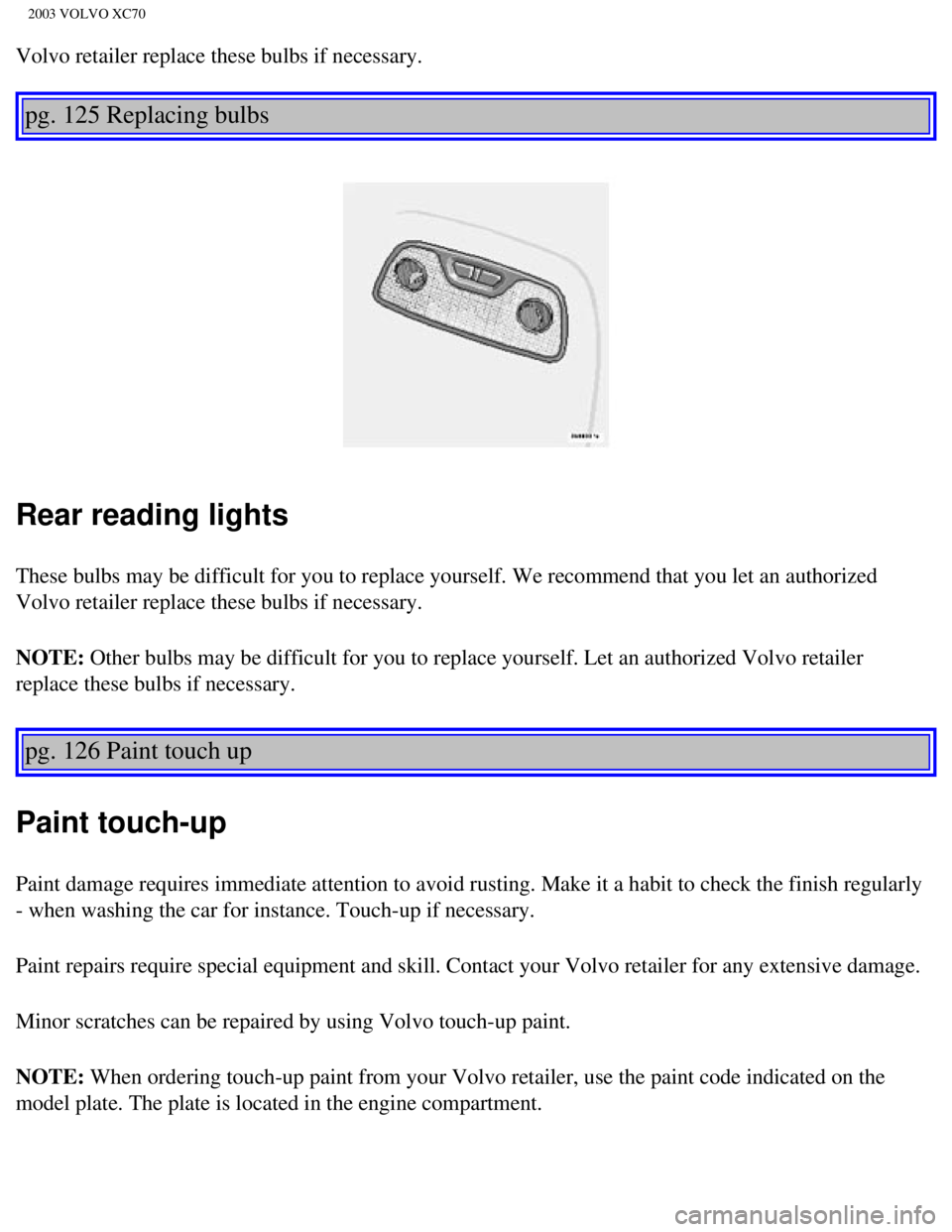
2003 VOLVO XC70
Volvo retailer replace these bulbs if necessary.
pg. 125 Replacing bulbs
Rear reading lights
These bulbs may be difficult for you to replace yourself. We recommend t\
hat you let an authorized
Volvo retailer replace these bulbs if necessary.
NOTE: Other bulbs may be difficult for you to replace yourself. Let an author\
ized Volvo retailer
replace these bulbs if necessary.
pg. 126 Paint touch up
Paint touch-up
Paint damage requires immediate attention to avoid rusting. Make it a ha\
bit to check the finish regularly
- when washing the car for instance. Touch-up if necessary.
Paint repairs require special equipment and skill. Contact your Volvo re\
tailer for any extensive damage.
Minor scratches can be repaired by using Volvo touch-up paint.
NOTE: When ordering touch-up paint from your Volvo retailer, use the paint cod\
e indicated on the
model plate. The plate is located in the engine compartment.
file:///K|/ownersdocs/2003/2003_XC70/03xc70_08a.htm (16 of 21)12/30/20\
06 4:18:03 PM
Page 183 of 257

2003 VOLVO XC70
several thin paint coats and let dry after each application.
3. If there is a longer scratch, you may want to protect surrounding pai\
nt by masking it off.
pg. 127 Washing the car
Washing the car
l The car should be washed at regular intervals since dirt, dust, insects \
and tar spots adhere to the paint
and may cause damage. It is particularly important to wash the car frequ\
ently in the wintertime to
prevent corrosion, when salt has been used on the roads.
l When washing the car, do not expose it to direct sunlight. Use lukewarm \
water to soften the dirt
before you wash with a sponge and plenty of water, to avoid scratching. \
l Bird droppings: Remove from paintwork as soon as possible. Otherwise the finish may be\
permanently damaged.
l A detergent can be used to facilitate the softening of dirt and oil.
l A water-soluble grease solvent may be used in cases of sticky dirt. Howe\
ver, use a wash place
equipped with a drainage separator.
l Remove dirt from the drain holes in the doors and rocker panels.
l Dry the car with a clean chamois.
l Tar spots can be removed with kerosene or tar remover after the car has \
been washed.
l A stiff-bristle brush and lukewarm soapy water can be used to clean the \
wiper blades. Frequent
cleaning improves visibility considerably.
l Wash off the dirt from the underside (wheel housings, fenders, etc.). \
l In areas of high industrial fallout, more frequent washing is recommende\
d.
CAUTION:
During high pressure washing, the spray mouthpiece must never be closer \
to the vehicle than 13" (30
cm). Do not spray into the locks.
Special sun roof cautions:
- Always close the sun roof and sun shade before washing your vehicle. \
- Never use abrasive cleaning agents on the sun roof.
- Never use wax on the rubber seals around the sun roof.
l When washing or steam cleaning the engine, avoid spraying water or steam\
directly on the electrical
components or toward the rear side of the engine.
l After cleaning the engine, the spark plug wells should be inspected for \
water and blown dry if
necessary.
file:///K|/ownersdocs/2003/2003_XC70/03xc70_08a.htm (18 of 21)12/30/20\
06 4:18:03 PM
Page 184 of 257
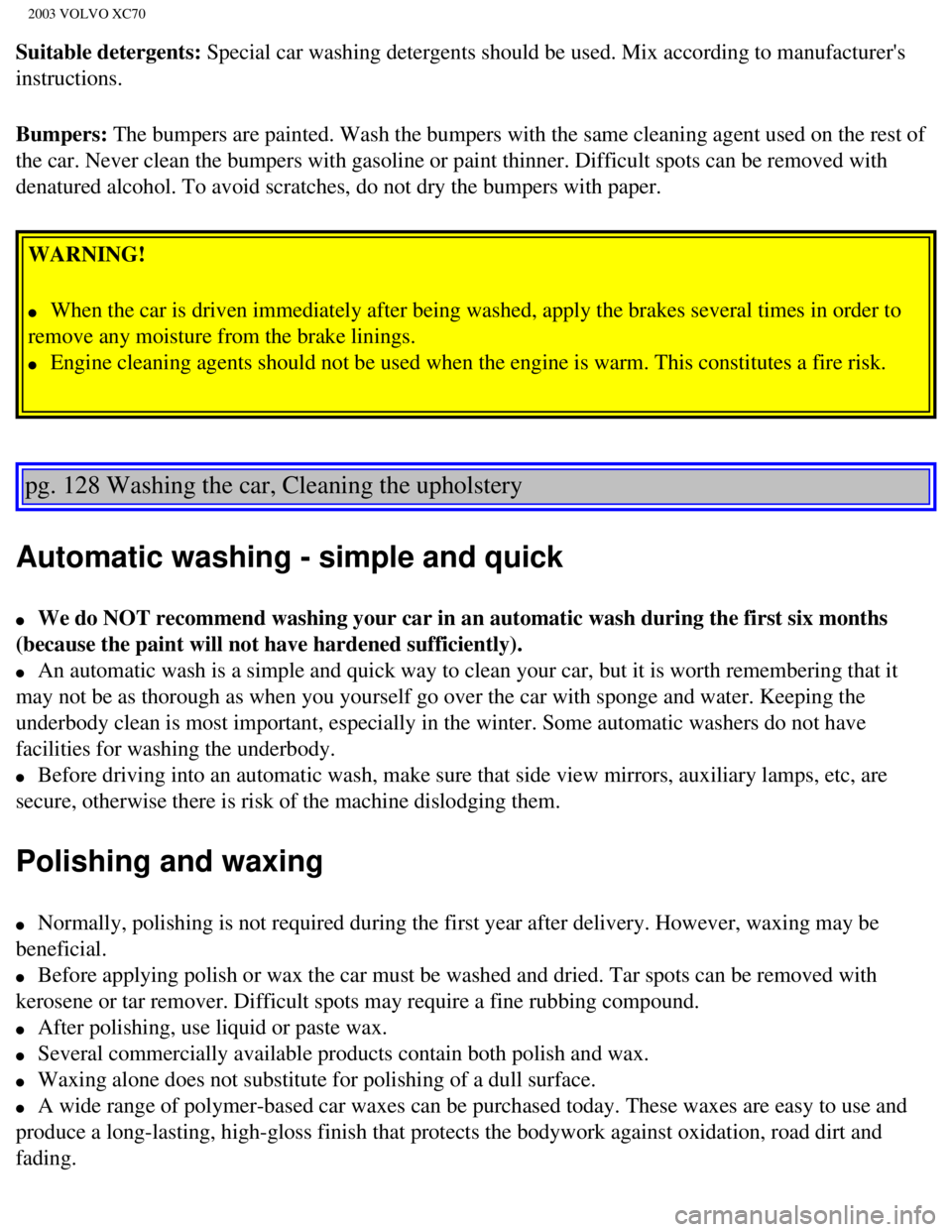
2003 VOLVO XC70
Suitable detergents: Special car washing detergents should be used. Mix according to manufac\
turer's
instructions.
Bumpers: The bumpers are painted. Wash the bumpers with the same cleaning agent u\
sed on the rest of
the car. Never clean the bumpers with gasoline or paint thinner. Difficu\
lt spots can be removed with
denatured alcohol. To avoid scratches, do not dry the bumpers with paper\
. WARNING!
l When the car is driven immediately after being washed, apply the brakes \
several times in order to
remove any moisture from the brake linings.
l Engine cleaning agents should not be used when the engine is warm. This \
constitutes a fire risk.
pg. 128 Washing the car, Cleaning the upholstery
Automatic washing - simple and quick
l We do NOT recommend washing your car in an automatic wash during the fir\
st six months
(because the paint will not have hardened sufficiently).
l An automatic wash is a simple and quick way to clean your car, but it is\
worth remembering that it
may not be as thorough as when you yourself go over the car with sponge \
and water. Keeping the
underbody clean is most important, especially in the winter. Some automa\
tic washers do not have
facilities for washing the underbody.
l Before driving into an automatic wash, make sure that side view mirrors,\
auxiliary lamps, etc, are
secure, otherwise there is risk of the machine dislodging them.
Polishing and waxing
l Normally, polishing is not required during the first year after delivery\
. However, waxing may be
beneficial.
l Before applying polish or wax the car must be washed and dried. Tar spot\
s can be removed with
kerosene or tar remover. Difficult spots may require a fine rubbing comp\
ound.
l After polishing, use liquid or paste wax.
l Several commercially available products contain both polish and wax.
l Waxing alone does not substitute for polishing of a dull surface.
l A wide range of polymer-based car waxes can be purchased today. These wa\
xes are easy to use and
produce a long-lasting, high-gloss finish that protects the bodywork aga\
inst oxidation, road dirt and
fading.
file:///K|/ownersdocs/2003/2003_XC70/03xc70_08a.htm (19 of 21)12/30/20\
06 4:18:03 PM